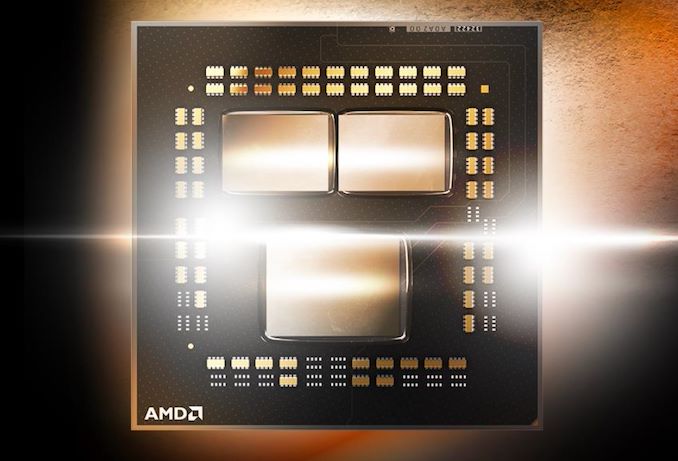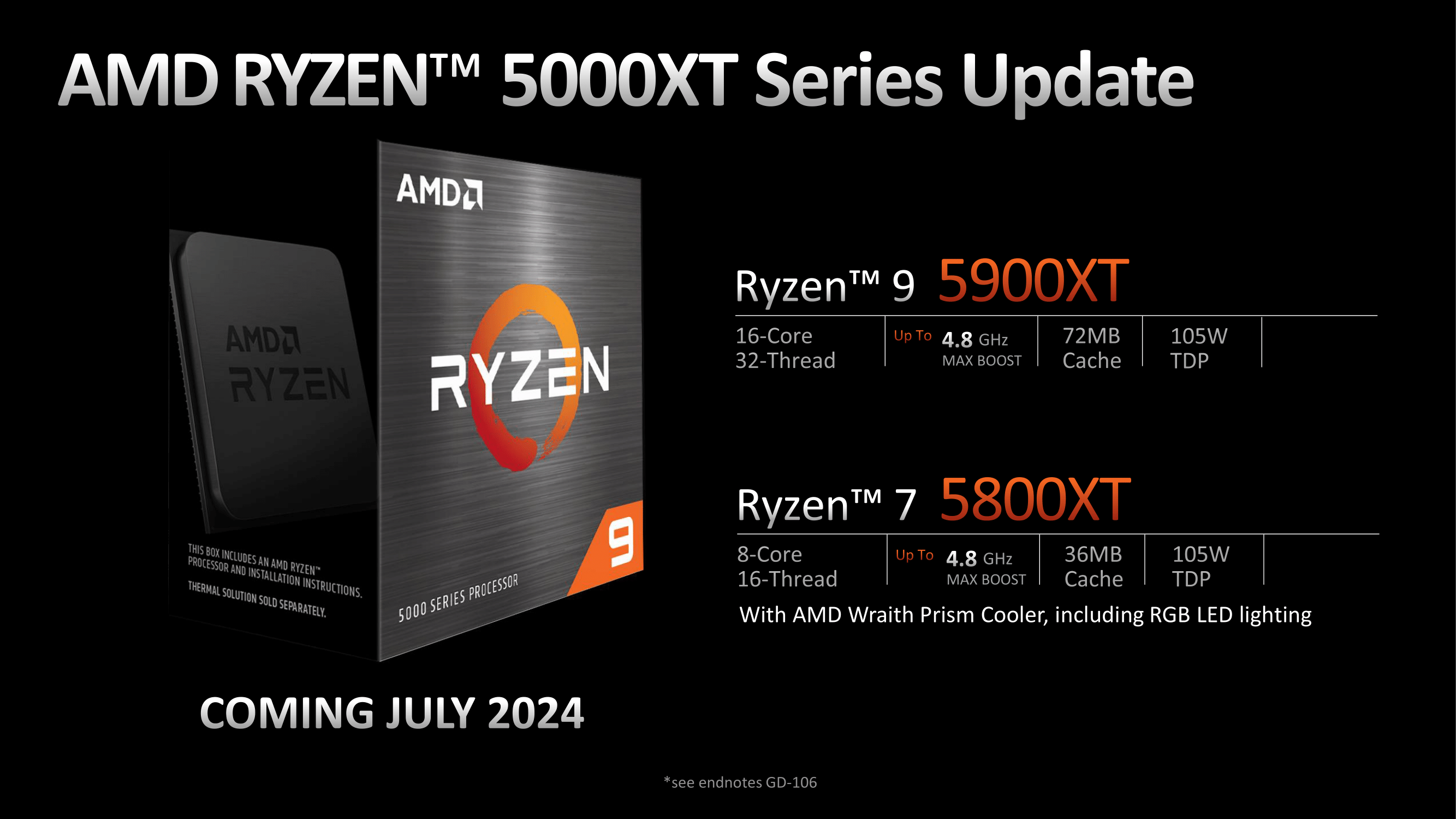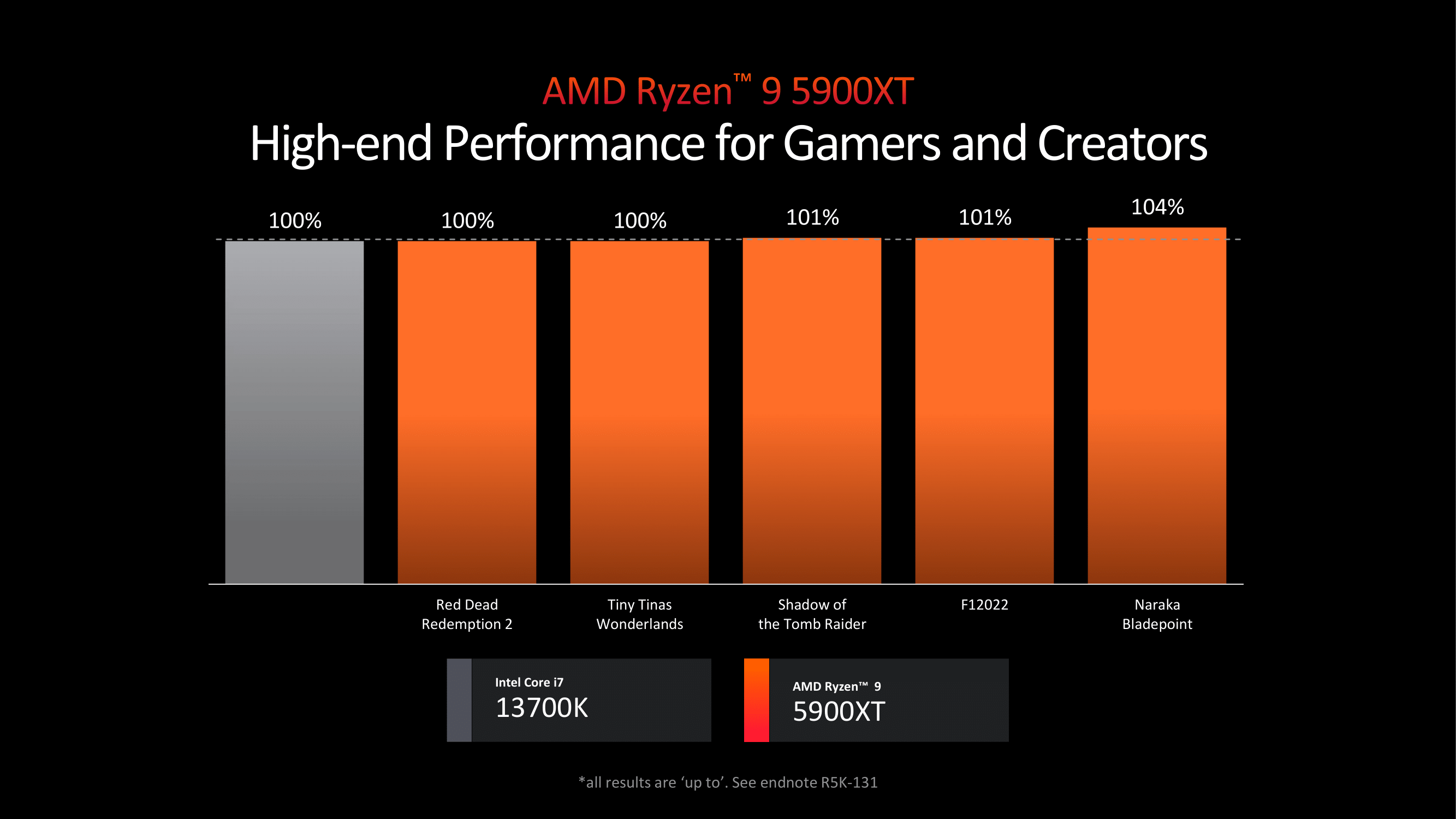AMD Launching New CPUs for AM4: Ryzen 5000XT Series Coming in July
by Gavin Bonshor on June 2, 2024 11:04 PM EST- Posted in
- CPUs
- AMD
- Trade Shows
- AM4
- Zen 3
- Ryzen 5000
- Computex 2024
- Ryzen 5000XT

During their opening keynote at Computex 2024, AMD announced their intention to launch a pair of new Ryzen 5000 processors for their legacy AM4 platform. The new chips, both getting the XT suffix, will be the Ryzen 9 5900XT, a 16 core Zen 3 part, while the Ryzen 7 5800XT will be an 8 core Zen 3.
The new chips are intended to underscore AMD's ongoing commitment to supporting their consumer platforms over several years. And while the specification changes are rather minor overall – the Zen 3 CPU architecture has long since been taken as far as it can reasonable go – it does give AMD a chance to refresh the platform by slinging hardware at new price points. AMD did something very similar for the Ryzen 3000 generation with the late-model Ryzen 3000 XT chips.
| AMD Ryzen 5000XT Series Processors (Zen 3) |
||||||
| AnandTech | Cores / Threads |
Base Freq |
Turbo Freq |
L2 Cache |
L3 Cache |
TDP |
| Ryzen 9 5950X | 16C / 32T | 3.4 GHz | 4.9 GHz | 8 MB | 64 MB | 105 W |
| Ryzen 9 5900XT | 16C / 32T | 3.3 GHz | 4.8 GHz | 8 MB | 64 MB | 105 W |
| Ryzen 9 5900X | 12C / 24T | 3.7 GHz | 4.8 GHz | 6 MB | 64 MB | 105 W |
| Ryzen 7 5800XT | 8C / 16T | 3.8 GHz | 4.8 GHz | 4 MB | 32 MB | 105 W |
| Ryzen 7 5800X | 8C / 16T | 3.8 GHz | 4.7 GHz | 4 MB | 32 MB | 105 W |
We've dedicated many column inches covering Zen 3 and the Ryzen 5000 series since they launched in late 2020, so there isn't anything new to add here. Zen 3 is no longer AMD's latest and greatest, but the platform as a whole is quite cheap to produce, making it a viable budget offering for new builds, or offering one last upgrade for old builds.
The Ryzen 9 5900XT is a 16 core part, and isn't to be confused with the Ryzen 9 5900X, which is a 12 core part. It ships with a peak turbo clockspeed of 4.8GHz, 100 MHz lower than the top-tier Ryzen 9 5950X. This makes it's XT designation somewhat of a misnomer compared to previous generations of XT chips, although it's clear that AMD has boxed themselves into a corner with their naming scheme, as they both need a way to designate that this is a new chip, and yet still place it below the 5950X.
Looking at the second chip, we have the Ryzen 7 5800XT. This is an 8 core part that does improve on its predecessor, offering a 4.8GHz max turbo clock that is 100MHz higher than the Ryzen 7 5800X's. Both chips otherwise share the same characteristics, including 6 MB of L2 cache and 32 MB of L3 cache, and all four of the chips – including the two new XT series and the corresponding X series chips – all come with a 105 Watt TDP.
In terms of motherboard compatibility, all of the AM4 motherboards that currently support the Ryzen 5000 series are also compatible with the Ryzen 5000XT series, although users are likely to need to perform a firmware update to ensure maximum compatibility; they are the same chips, but the microcodes are likely different.
AMD has provided some gaming performance figures comparing the Ryzen 9 5900XT to Intel's 13th Gen Core i7-13700K. It does offer very modest yet marginal gains in games by up to 4%; it's not mind-blowing, but the price could be the decisive factor here.
Regarding price, AMD hasn't disclosed anything official yet ahead of the expected launch of the Ryzen 5000XT series chips in July. It's hard to make a case for a pair of chips to be considered a fully-fledged series, but it does open up the doors for AMD to perhaps launch more 5000XT series chips in the future.












18 Comments
View All Comments
nandnandnand - Sunday, June 2, 2024 - link
Table is messed up. Lists 5800XT and 5800X as 12-cores.Ryan Smith - Monday, June 3, 2024 - link
Fixed. Thanks!ballsystemlord - Monday, June 3, 2024 - link
The naming scheme mix-up is laughable. 5900XT is a joke name.nandnandnand - Monday, June 3, 2024 - link
It is weird. They should have dropped the X instead, since there's a 5900 non-X.Still a good thing that more chips are being pushed into the market which will drive down AM4 prices.
GeoffreyA - Monday, June 3, 2024 - link
New chips on AM4 are good. I wonder how many people are going to get BIOS updates.nfriedly - Monday, June 3, 2024 - link
Yeah, agreed. "5950" (non-X) is the obvious name to fit within their existing naming convention. Why are companies so awful at naming things?NextGen_Gamer - Monday, June 3, 2024 - link
Came here to further agree with this. The Ryzen x900 series has long since been 12-cores parts, with the x950 series being the 16-core ones. How AMD named this 5900 XT instead of 5950 is just pure craziness.Zoolook13 - Tuesday, June 4, 2024 - link
Mostly because its marketing people involved, they frown on logic.peevee - Tuesday, June 4, 2024 - link
They are overclockable, so X.Could have been 5940X.
abufrejoval - Monday, June 3, 2024 - link
What I'd really like to know is the real business driver behind these chips.Like:
How old are these CCDs? Are these CCDs that have been stockpiled for EPYCs that finally didn't sell? They are obviously good dies with a full working set of cores: are they just emptying a bin that grew full over time or are they down-binning perfect chips just to get them out of inventory?
Would they actually have TMSC making these CCDs new on a super mature process at minimal number of SKUs because they get a fab-line-going-out-of-business deal but want to avoid getting stuck with too many bins and more than a single SKUs that won't package and sell in the end?
Are these EPYC qualified CCDs, but Zen 3 EPYCs no longer have matching IODs or just won't sell even at rock bottom prices?
So many interesting insights I'd love to know!
And I wonder if these 5800XT will eventually sell at similar prices as a Ryzen 5 9600X or at which point the landfill gate opens up.
Between an i3-N305 and a 5800XT at iso prices, I know where I'd go...